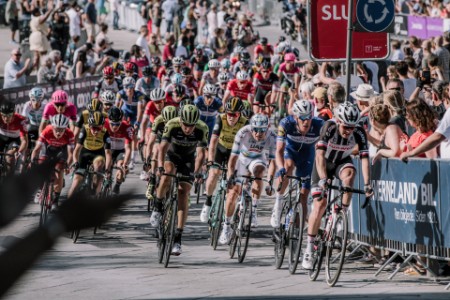
The better the question
How can you turn spectators into fans?
The sport of cycling has a money problem. Can the sport create a platform that can effectively engage and monetize global viewership?
On the face of it, professional cycling should be easy to monetize. With more than a billion bicycles in the world, there is an opportunity to show casual cyclers the thrill of watching professionals race on TV.
Yet, despite growing interest from media network providers and an expanding fanbase, the sport of cycling has been stubbornly resistant to effective monetization. However, a consortium of professional cycling teams dedicated to resolving this issue came to EY professionals for help.
The teams want to answer one critical question: How do we improve the monetizing possibilities of the sport?
Why has generating revenue for professional cycling been so dysfunctional? For a perspective on the opportunities, global commercial cycling revenues are only US$600 million – compared to US$8.2 billion in the NFL (National Football League), and US$16.8 billion between the five biggest European football leagues.
The difference is these sports benefit from being able to host large, ticketed events at a singular location. Cycling, where races cover thousands of miles of open road, does not have this luxury for the overwhelming majority of events. Without equivalent infrastructure, cycling struggles to achieve the commercial heights of other sports.
Ironically, with pro cycling, it’s the most dedicated fans – those close to the action and watching by the roadside – who can miss the most. More casual viewers, watching on TV or listening on the radio, can get a more holistic coverage of the race; fans by the roadside can only catch a glimpse of the cyclists as they go past.
But cycling does have its own assets: professional cyclists generate huge amounts of data from heart rate, to bike speed, to information about the terrain on which they are riding. Properly captured, this data presents a huge opportunity for cycling superfans to develop closer, and more intimate engagements with the sport and their favorite teams and riders.
The teams have close access to these opportunities – they generate terabytes of raw data every year. Their goal was to capture, transform and deliver this data in an enticing and impactful manner to a global cycling audience of 565 million people.
This presented a fascinating problem: how do you transmit thousands of data points per second out of a live sporting event while it moves from Bologna to Rome, all across the Alps and everywhere else? You can transmit data at a stadium, though difficult, but how can teams do it in a bike race that moves 200 miles down the road every day? The EY professionals responded, “This is a fantastic IoT challenge.”
And if EY professionals and the teams could overcome the challenge, they would have the opportunity to give fans worldwide a leading platform to directly engage with cycling – as the event is happening – and create the monetizing foundations for a truly effective commercial cycling economy.
Related article

The better the answer
Converting casual spectators into fans through live data
By using IoT solutions to leverage the data generated by professional cyclists, EY and the teams were able to build a platform that brings cycling closer to the fans.
Together with Microsoft, EY professionals were able to build a Microsoft Azure cloud platform to collect the live data generated by professional cyclists. The platform uses the data to create interactive, revealing data highlights and stories streamed direct to teams, to TV screens during live broadcasts and via a dedicated app. This puts viewers at the heart of the race, forges a closer connection with the visceral test of strength and endurance of each cyclist, and gives fans deep insights into their favorite cyclists and teams. The digital experience could then become a new one-stop shop for cycling fans everywhere, building and growing a large audience of cycling fans and potential consumers. The increased customer base forms the foundation for a more sustainable cycling economic model. EY professionals and the teams wanted to show every rider and let people see them in ways that no one had ever done before - in any sport - and on a massive scale.
Bringing together multiple teams from around the world, including the US, Australia, India, Denmark and the UK, EY teams worked with the professional cycling teams to create a platform that could achieve these aims. The solution had three parts:
1. A robust IoT system to capture and transmit the required data
The first step was to find an IoT device that could collect the necessary data from the cyclists. This is a small device that is placed under the saddle of bikes in the professional peloton. The device captures critical information about the cyclists as they participate in races – all of which is both useful for the teams in tracking performance, and fascinating for fans to follow the progress of the race. The information it provides includes:
- Power
- Cadence (the speed at which the cyclist peddled)
- GPS information (location, bike speed, and direction of travel)
- Heart rate information

To capture real-time data, bikes are fixed with network-connected devices which send data to the cloud portal.
To capture real-time data, bikes are fixed with network-connected devices that send data to the centralized cloud portal.
“It’s been an incredibly complicated technical challenge to get that information, and then do something sensible with it, that we can drive insight from, visualize and show to consumers in a meaningful way,” says Michael Henry, Director, Analytics practice, Ernst & Young LLP. “We’re taking vast amounts of information across bikes that move up to 100 kmph, and they’re traveling across thousands of miles for eight hours at a time. So, we’ve got some extremely technical challenges when doing that, over mountains and incredibly isolated terrain, for long periods. We had challenges with waterproofing, battery life and also the precision and accuracy of the bikes and where they are.”
With an average of 150 riders in most professional races, special care needs to be taken to help ensure that each cyclist is paired with the correct device each morning to build up the correct aggregate race data. The solution captures data packets every second of the race from start to finish. The algorithms are conducting more than 1.2 billion real-time data transformations performed each race day to produce the real-time race insights. And with data becoming ever more fundamental to the sport, one error in refitting a device could create significant problems for the teams, organizers and broadcasters – and potentially lose the trust of the fans.
2. A trusted, secure central data aggregation platform
After gathering the data on the bikes, it needs to be relayed to a central platform, which aggregates rider data and combines it with external information sources (such as team names, stats and route maps) to enable deeper analysis and insight.
Additionally, some of the data being collected needed to be kept proprietary to the individual racing teams. After all, these teams are in competition, and use data to benchmark, analyze and improve their performances – all in a sport that generates prize money and sponsorship opportunities for the winners. While some of the aggregated data is made public, there also need to be clear firewalls between sensitive information that could give competitors unfair insights into each other’s performance and tactics.
The solution was the EY data platform, which provides a broad capability for high-speed streaming ingestion, storage, cognitive analytics, artificial intelligence – and of course data security with reliable authentication and encryption protocols. With cloud computing, the platform helped enable large network access, both inbound and outbound, and can be scaled according to the request count in real time. Within the project, this provided the backbone for building the aggregation and analytics functions of the app.
The cloud solution makes it possible to collect, process and aggregate live data from moving objects and the athletes’ own bodies. And using that data via the app also points the way forward for more data-enabled sport in general. “What is clear is that the way fans interact with sport is changing,” says Tom Kingsley, EY UK Sport Industry Group Leader. “Whether in a stadium, by the side of a road or watching at home, fans want a much more immersive experience. What we’re developing will significantly improve the way cycling fans can engage with their sport. That has to be a good thing for fans, for teams and for the sport as a whole.”
3. A platform for communicating data and insights to the wider viewing public
Bike races are made up of key moments with unanswered questions to be addressed. For example:
- Who achieved the fastest speed on a descent?
- Which teams are working hardest or secretly conserving energy?
- How much power do the sprinters need to win?
The answers are in the data. So, a “moment card” carousel in the app Race Center continuously publishes insights, making every part of a race more interesting and insightful.
The EY teams also used AI and professional opinion to heighten excitement during the race. For instance, the solution combined and analyzed a large quantity of effort data and performances at different terrains, physical capability of the riders, current form, coupled with insights from leading sport scientists. And the result was that EY teams were able to define a performance metric effort indicator – the “red zone”. Riders have a physiological threshold, which can be quantified in power (watts). When the riders go over this threshold, they accumulate exhaustion that they can’t recover from in the short-term.
Ultimately, the user-facing app aims to give cycling fans the same kind of all-in-one experience fans of other sports would experience in a stadium. Fans can expect a constant overview of the state of play, running commentary and statistics, and a sense of community and participation in the event itself. As Robin Hutchinson, EY Global Digital Products and Solutions Leader, explains, “The app means they can watch the broadcast sitting on the side of the road, uploading pictures, consuming the data and really getting a great experience. It changes what cycling looks like to the fan.”

The better the world works
Integrating the fan into the sport for a richer experience
Creating a one-stop-shop for global cycling fans, laying the foundations for an effective cycling business model.
The platform has seen considerable success. Over more than two years of gradual rollout and development, nearly a million people have participated in some part of the app ecosystem, and millions more have consumed the data via TV broadcasts.
“What we’re basically providing is a second-screen experience. You’re inside the race, you get to see things that the motorcycles and the cameras don’t capture, you get to see things helicopters don’t capture, and that’s all delivered to you in a way that gives you more fidelity for what’s happening in that race,” says Hutchinson.
The platform offers the teams several routes for monetization such as sponsor and advertisers and a freemium app. The freemium model of the app is being built, and will give fans access to enhanced features, such as the ability to compare their own performance to that of professional racers.
But at its heart, EY teams platform shows that with the right data and experience, it’s possible to create an entirely new and engaging fan experience for cycling. This enhanced level of insight and data has the potential to fuel more biking participation, which could promote healthier lifestyles, more sustainable transport and creates a more profitable, more innovative, talent-hungry cycling business sector.




